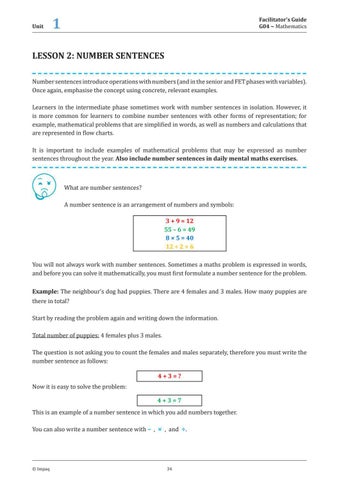Unit
1
Facilitator’s Guide G04 ~ Mathematics
LESSON 2: NUMBER SENTENCES Number sentences introduce operations with numbers (and in the senior and FET phases with variables). Once again, emphasise the concept using concrete, relevant examples. Learners in the intermediate phase sometimes work with number sentences in isolation. However, it is more common for learners to combine number sentences with other forms of representation; for example, mathematical problems that are simplified in words, as well as numbers and calculations that are represented in flow charts. It is important to include examples of mathematical problems that may be expressed as number sentences throughout the year. Also include number sentences in daily mental maths exercises. What are number sentences?
A number sentence is an arrangement of numbers and symbols: 3 + 9 = 12 55 – 6 = 49 8 × 5 = 40 12 ÷ 2 = 6
You will not always work with number sentences. Sometimes a maths problem is expressed in words, and before you can solve it mathematically, you must first formulate a number sentence for the problem.
Example: The neighbour’s dog had puppies. There are 4 females and 3 males. How many puppies are there in total?
Start by reading the problem again and writing down the information. Total number of puppies: 4 females plus 3 males.
The question is not asking you to count the females and males separately, therefore you must write the number sentence as follows: 4+3=?
Now it is easy to solve the problem:
4+3=7
This is an example of a number sentence in which you add numbers together. You can also write a number sentence with – , × , and ÷.
© Impaq
34



